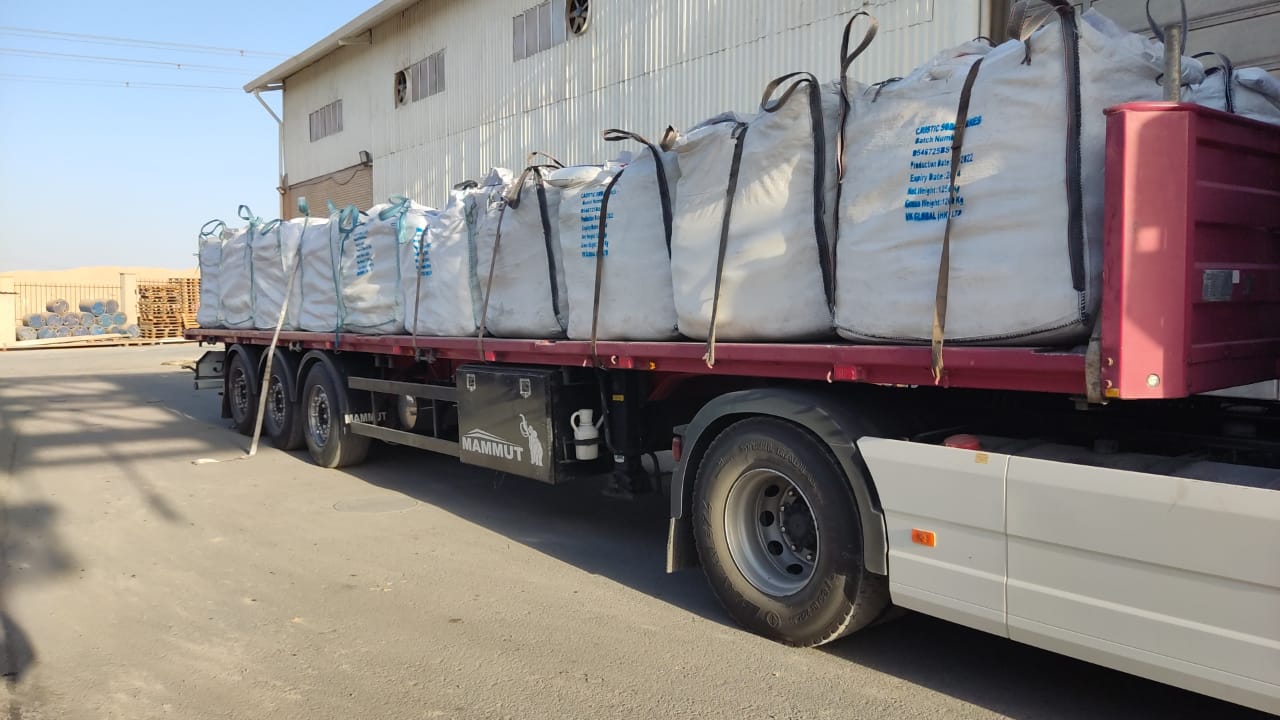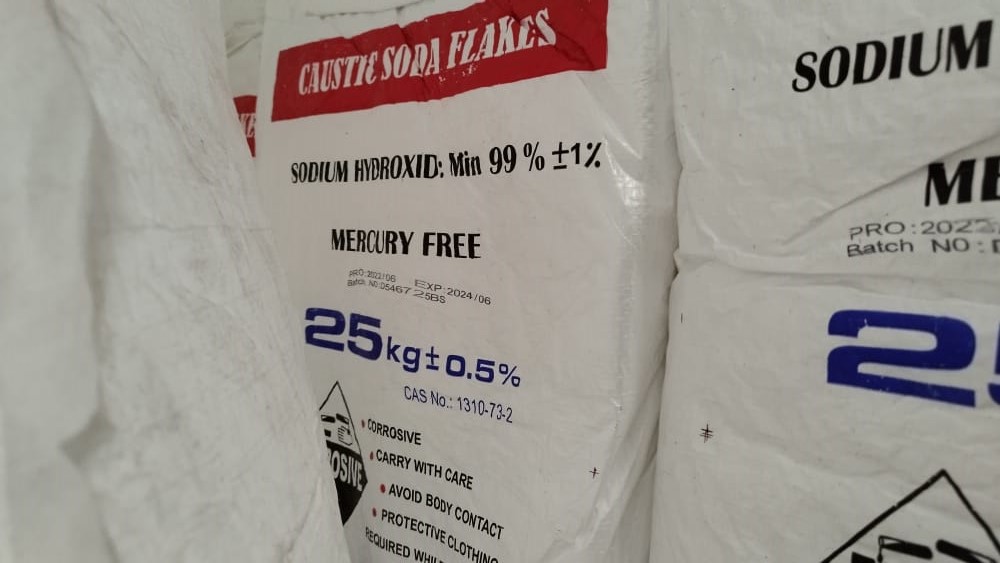caustic soda

Caustic Soda Description
Caustic soda is one of the common names for sodium hydroxide (NaOH). Its common name derives from its chemical identity as a sodium hydrate and because it is caustic or corrosive.In pure form, caustic soda is a waxy, white solid. It readily absorbs water and forms aqueous solutions.
Caustic soda is the most popular alkali in the world. For industrial needs, around 55.5 million tons of it is manufactured. It is classified in the group of strong chemical bases, as it completely dissociates (dissolves) in water.
Other names of the substance:
- sodium hydroxide
- dye
- caustic (find out why it’s called this – because of the severe burns it causes to the skin)
- caustic alkali. It’s a white powder with large particles. It’s very hygroscopic, and in the air the powder swiftly melts, as it actively absorbs water vapor.
Caustic Soda is available in many forms in the industry, and the most common forms are caustic soda flakes and caustic soda pearls. Sodium hydroxide as a strong base, is considered from one of the most important industrial chemicals and strong absorbent of moisture.
caustic soda is used in many industries in the manufacture of pulp and paper, textiles, drinking water, soaps and detergents and as a drain cleaner.
Caustic Soda Uses
It is used for soap making, homemade biodiesel, frosting glass, making several foods, and for chemistry experiments.
Caustic Soda also Used in below industries:
- Production of aluminum
- Production of various types of sodium silicate
- Production of detergent powders and dishwashing liquid
- Production of vegetable oil, leather, and mineral products
- Production of viscose fiber
- Food processing industries
- Production of calcium hypochlorite
- Production of bleach and various types of organic and inorganic derivatives of sodium
- Production of PVC
- Production of degreasing and cleaning agent for greasy surfaces and pipes
- Olive Processing
Caustic Soda Extention
Why is so much caustic soda used in industry all over the world?
- All household washing agents, shampoo and soap have a certain amount of caustic soda added to them
- It can be used in the manufacture of paper, polyester fiber and cardboard
- In aluminum manufacture, caustic soda is added for pickling metal
- Caustic soda is registered as a food additive. It is used to make crunchy crusts
- Soda solutions are used at food factories as a very powerful washing agent which breaks down fats. This component must be used in peeling fruit
- Solvents for unblocking pipes are also solutions of caustic soda.
- Biodiesel fuel (a discovery in the field of ecology) – caustic is needed as a catalyst
- Sodium hydroxide is used for testing reactions at chemical plants
- It also has an interesting method of application in medicine – for burning off skin growths; after application a scab appears
Caustic Soda Chemical Reaction:
The solution has a strong alkaline reaction, turning litmus paper dark blue (with phenolphthalein the presence of the OH group gives a raspberry color, with methyl orange it may seem yellow).
This is a very active substance, it reacts with almost any chemical compound:
- with acids it forms salts and water;
- with amphoteric hydroxides;
- with amphoteric oxides (this reaction forms water and complex compounds);
- with salts, caustic soda can provide the effect of precipitation of metals, it forms a sediment in the form of metal hydroxides (you can see this reaction with the example of aluminum);
- with non-metal and halogens;
- with metals (apart from iron and copper, as they have a low electrochemical potential);
- with ethers and alkyl halides a hydrolysis reaction arises;
- with polyatomic alcohols, reagents may transform into alkoxides;
- with fats it is used for the irreversible reaction of saponification, as in the process fats turn into soap and glycerin.
Caustic Soda Packing:
There are different kind of packing for industrial caustic soda flake, since caustic soda /sodium hydroxide is chemical product better to pack in 25 kgs 2 layer laminate PP bag and don’t allow any water to moisture enter the bag , also for transportation and reducing labor charges we can put bags in 1250 Kg jumbo bag or 1250 Kg pallets are possible.
Food grade caustic soda flake ship in safe metal container which keep away soda from moisture and humid condition , Hydroxide is hydrophilic which means that it not only attracts moisture and water but it actively absorbs any moisture or water to which it is exposed.
Caustic Soda Specification:
| Row | Test name | Unit | Degree Importance | Accepting limit | Test result | Test Method |
| 1 | Purity of Sodium Hydroxide (NaOH) | %W | Important | 98 ± 1 % | 99.16 | ISIRI- 364 Clause 1 – 7 / IRISI 6135 |
| 2 | Carbonate as Na2CO3 | %W | Important | Max 1 | 0.43 | ISIRI- 364 Clause 2 – 7 / IRISI 6135 |
| 3 | Chloride as NaCI | %W | Important | Max 0.06 | 0.0085 | ISIRI- 364 Clause 3 – 7 / IRISI 2535 |
| 4 | Sulfate as Na2SO4 | %W | Important | Max 0.01 | 0.0047 | ISIRI- 364 Clause 4 – 7 / IRISI 2539 |
| 5 | Silicate as SiO2 | %W | Important | Max 0.02 | 0.0019 | ISIRI- 364 Clause 5 – 7 / IRISI 2531 |
| 6 | Fe | Mg/Kg | Important | Max 30 | 12.5 | ISIRI- 364 Clause 6 – 7 / IRISI 2537a |
| 7 | Insoluble in Water | %W | Important | Max 0.1 | 0 | ISIRI- 364 Clause 7 – 7 / IRISI 7904 |
| 8 | Aluminum as Al2O3 | Mg/Kg | Important | Max 20 | <20 | ISIRI- 364 Clause 8 – 7 / IRISI 7903 |
| 9 | Heavy Metals as Pb | Mg/Kg | Important | Max 20 | <20 | ISIRI- 364 Clause 9 – 7 / IRISI 7905 |


